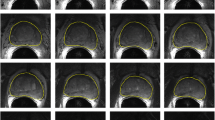Abstract
The correction of organ movements in sequential radionuclide renography was done using an iterative algorithm that, by means of a set of rectangular regions of interest (ROIs), did not require any anatomical marker or manual elaboration of frames. The realignment programme here proposed is quite independent of the spatial and temporal distribution of activity and analyses the rotational movement in a simplified but reliable way. The position of the object inside a frame is evaluated by choosing the best ROI in a set of ROIs shifted 1 pixel around the central one. Statistical tests have to be fulfilled by the algorithm in order to activate the realignment procedure. Validation of the algorithm was done for different acquisition set-ups and organ movements. Results, summarized in Table 1, show that in about 90% of the simulated experiments the algorithm is able to correct the movements of the object with a maximum error less or equal to 1 pixel limit. The usefulness of the realignment programme was demonstrated with sequential radionuclide renography as a typical clinical application. The algorithm-corrected curves of a 1-year-old patient were completely different from those obtained without a motion correction procedure. The algorithm may be applicable also to other types of scintigraphic examinations, besides functional imaging in which the realignment of frames of the dynamic sequence was an intrinsic demand.
Similar content being viewed by others
References
Barber DC (1982) Automatic alignment of radionuclide images. Phys Med Biol 27:387–396
Geckle WJ, Frank TL, Links JM, Becker LC (1988) Correction for patient and organ movement in SPECT: application to exercise thallium-201 cardiac imaging. J Nucl Med 29:441–450
McKeighen RE (1979) Improved means of correcting motion blurring in scintigraphic images. Phys Med Biol 24(2):353–362
Phillips RL, London ED, Links JM, Cascella NG (1990) Program for PET alignment: effects on calculated differences in cerebral metabolic rates of glucose. J Nucl Med 31:2052–2057
Tolwinski J, Mikilajkov A (1975) Evaluation of the effect of respiratory movements of the organs on the resolution index. Nucl Med 13:355–359
Vidiukov VI, Rotenberg EM (1982) Superposition of scintigraphic images using a computer. Med Tech 4:55–57
Author information
Authors and Affiliations
Additional information
Offprint requests to: A. De Agostini
Rights and permissions
About this article
Cite this article
De Agostini, A., Moretti, R., Belletti, S. et al. A motion correction algorithm for an image realignment programme useful for sequential radionuclide renography. Eur J Nucl Med 19, 476–483 (1992). https://doi.org/10.1007/BF00185852
Received:
Revised:
Issue Date:
DOI: https://doi.org/10.1007/BF00185852




